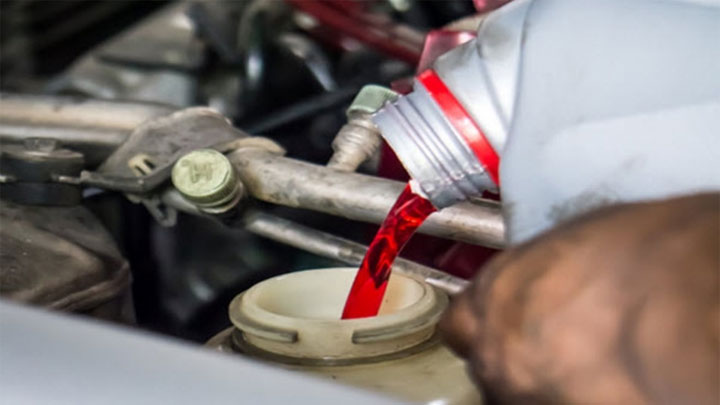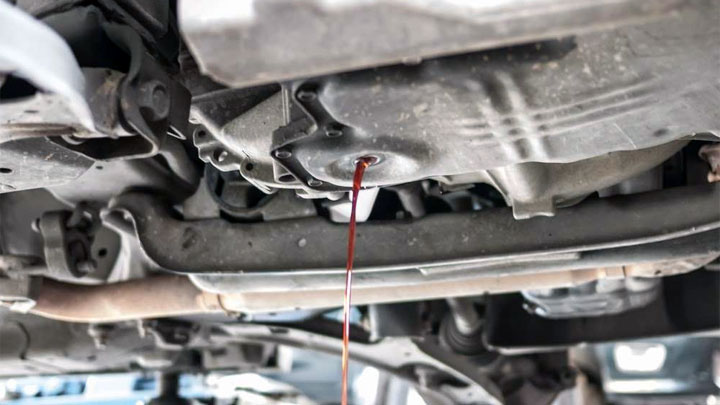Last Updated on October 17, 2022
In order for the gears inside your vehicle to move smoothly, they rely on transmission fluid to do the job. Checking the amount of transmission fluid that you have left is similar to the way in which you check your level of engine oil.
The only difference is that you check your transmission fluid while the engine is running because it is associated with a closed system. This means that you should never be low on transmission fluid. If you are, then either top off your fluid right away or take your vehicle to an auto repair shop.
Good quality transmission fluid is what you should care more about than volume, though. If the transmission fluid smells burnt or looks brownish, then you need to get new transmission fluid. If it is red with no burning smells, then the fluid is fine.
Related: Transmission Fluid Color Chart (What the 5 Colors Mean)
Changing Transmission Fluid
The majority of car owners don’t think about their transmission fluid. The only thing you tend to hear is some owners of automatic transmission cars saying it is important to make sure you’re not low on transmission fluid, you haven’t overfilled it, and that it’s imperative to change or flush your transmission fluid at recommended intervals.
However, those with manual transmission vehicles must pay close attention to their gearbox. If the oil inside is too old, there will be a buildup of sludge and metal shavings.
The information described below discusses how often it is recommended to change your transmission fluid in an automatic transmission vehicle and a manual transmission vehicle.
Automatic Transmission Fluid Change Interval

The transmission fluid in your automatic transmission vehicle will eventually deteriorate and go bad or get burnt. The fluid will deteriorate faster if you’re regularly stopping and going in city traffic, towing trailers, or carrying heavy loads on the vehicle.
The reason this makes the fluid deteriorate is because the transmission heats up more as it is operating. The hotter the fluid, the more stress that’s put on the fluid and the transmission itself.
And since the fluid is responsible for allowing the gears to move smoothly, deteriorated fluid which is thicker than it should be, will make the gears work harder than usual.
The manufacturers of most automatic cars will tell you that you should change the transmission fluid every 60,000 to 100,000 miles. But if you were to ask a mechanic, they would likely tell you that this is too long to wait.
Automatic transmission fluid should be changed every 30,0000 to 50,000 miles instead. But again, check your owner’s manual for the proper change and flush interval and use that as a guideline. In the grand scheme of things, the cost to change transmission fluid is small compared to possible damage to your transmission.
Manual Transmission Fluid Change Interval
The manufacturers of most vehicles recommend that you change your manual transmission fluid or gear oil at least every 30,000 miles or at the most 60,000 miles, depending on the make and model of the manual vehicle.
You’ll want to check your car manual for the actual recommended interval. But if you are constantly putting your manual transmission under stressful conditions, then the fluid should be changed sooner, maybe even at 20,000 miles.
Stressful conditions for a manual car would be regularly driving short distances such as stop and go city traffic while very rarely going on the freeway or out of town. These short drives force the gears of a manual car to have to change constantly, which puts the transmission under stress.
Other ways stress can occur is when new drivers are first learning the proper way to change gears. Often times, they will make mistakes such as grinding gears which end up causing additional stress on the internal gears.
Related: Reasons Your Manual Transmission is Hard to Shift
Conclusion
Whether you have an automatic or manual transmission, the process of changing transmission fluid will take some time. First, the mechanic must support the vehicle and then drain the old fluid from the transmission.
Before the new fluid is added, any gaskets or seals for the fluid need to be checked to make sure no transmission fluid leaks are present. Don’t try doing this job yourself because it requires professionals who know what they are doing.





My 1992 ford ranger will no go into gear while running if you turn off truck press clutch put it into gear start it you can engage the transmission in any gear you put it in but while engine is on will not go in to gears what do I got to do to fix this
Sounds like your clutch’s slave cylinder is either leaking fluid or is completely out of fluid. Get it fixed ASAP as this can ruin your clutch and greatly increase the cost of repair. Most clutches today are hydraulic, so this is a common problem.
Very timely article! I have a 2012 Nissan Rogue with a CVT transmission ~115k miles giving pronounced trouble including lurching, struggling for power on short inclines and lurching in drive with no acceleration applied. Normal driving no towing. Fluid changed at 35k and 100k miles. No fluid issues mentioned during changes. Is this sign of imminent death?
It’s not a good sign, that’s for sure. I would take it to a transmission shop and see what they think. You’ll probably want to get it checked out before it gets any worse.
I have a 2007 Honda Civic Automatic & it drives great except for when I come to a stop and try to speed up again, when going into 2nd gear it will hesitate to accelerate and when I try to “speed up” say to pass someone or something it takes awhile for the rpm’s to go up and to speed up. I have recently changed the spark plugs & did a fuel system clean & no change. I checked my trans fluid and it is a dark brown color, would that cause the hesitation? Im praying I can just get a flush done and I don’t need a new trans cause I JUST bought this car a week ago!!😥
I don’t know if that is the cause of the hesitation or not. How many miles does your car have on it? Do you have any records of the transmission fluid ever being changed?